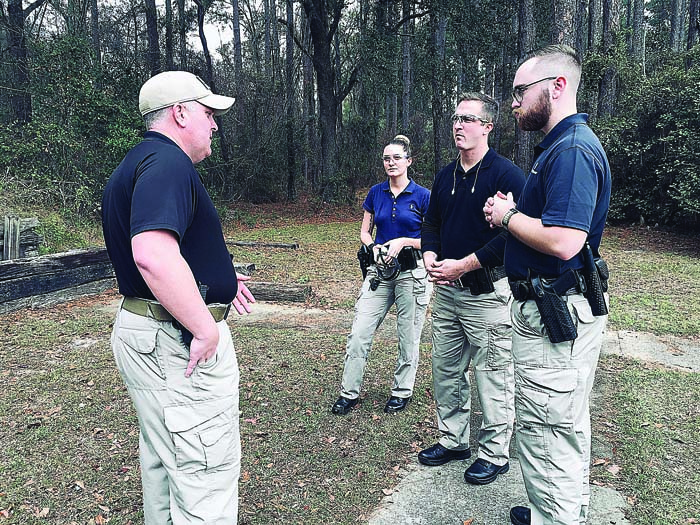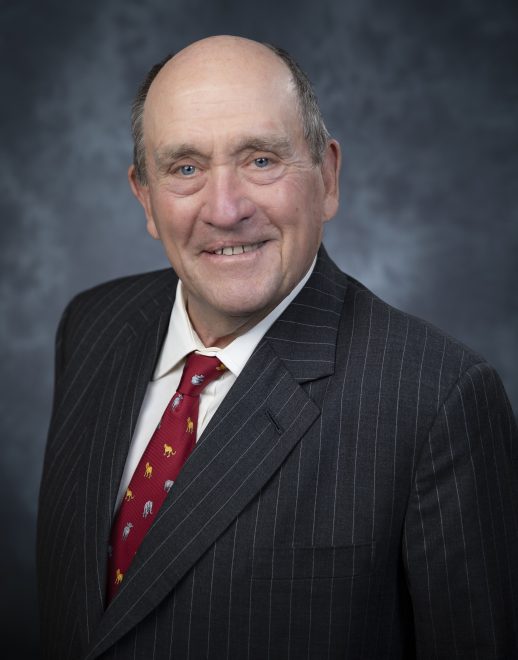The Blue Light Effect: 2019 continued downward trend of crime rate
Published 12:50 pm Monday, January 6, 2020

- Deputy Chief Michael Cox, left, of the Moultrie Police Department, takes, from left, Katelynne Nitschke, Michael Bowling and Micah Marlette through a four-week pre-academy training course before they’re sent off to the police academy. Bowling is aiming for a job at the Moultrie Police Department while Nitschke and Marlette are seeking positions at the Adel Police Department.
MOULTRIE, Ga. — If blue lights are in neighborhoods then those wanting to commit crimes there will find themselves less likely to do so.
With this philosophy — this motto — Moultrie Police Chief Sean Ladson strove to decrease property crimes. It was one of his first focuses when he became acting chief in 2017. He succeeded.
At the end of 2016 — prior to Ladson joining the Moultrie Police Department — property crimes totaled 1,006. This included 181 burglaries, 795 larcenies, 30 motor vehicle thefts and no arsons.
Ladson, after taking his oath, stated that he and the MPD would be identifying and targeting high-crime areas. For property crimes, those had to be found pretty quick if a solution was to be found.
“Property crime rates were higher in the southeast but it’s because it’s a bigger area,” Ladson said. “What we did was we focused our police officers in a traffic enforcement capacity, but we focused it in the neighborhoods — northwest, southwest, northeast, southeast.”
This process was twofold. MPD officers would enforce traffic laws making sure pedestrians and motorists alike were safe, while also patrolling for potential offenders.
Ladson followed his motto and saw an effective change at the end of 2017. Property crimes totaled 817 that year: 1 arson, 111 burglaries, 676 larcenies and 29 motor vehicle thefts — an 18.8 percent decrease from 2016.
The downward trend followed into 2018 with 711 property crimes, a 13 percent decrease from the year prior.
As of August, property crimes in 2019 reached 380. At the same time in 2016-2018, property crimes totaled 688, 537 and 536 respectively.
Comparing 2019 to 2016 specifically shows a 44.7 percent decrease in property crimes for August. Comparing 2019 to the year prior showed a 29 percent decrease, which showed the current strategy was working.
Now, another issue needed be tackled: a rise in gang activity.
But this isn’t merely a focus on person-on-person crimes. Deputy Chief Michael Cox said the focus is more so on the young people being drawn into gangs.
The whole of it won’t be ignored though, Ladson said.
“Too many chiefs and sheriffs think it’s a bad reflection to admit they have gangs,” Ladson said. “Gangs didn’t show up when I became chief, they’ve been here.”
Ladson said there’s no more gang activity here than in surrounding cities like Valdosta, Tifton and Thomasville, but if there’s a chance to head things off, they’ll take it.
Choice Barnes, the gang intelligence officer who set up Moultrie’s gang task force, said it’s all about noticing patterns. He helps in identifying and validating gang members while also building a database of gang activity.
Barnes also helps determine if children and teens are a part of a gang or at risk. But this is a partnership scenario.
“When [dealing with] younger kids, with the assistance of the school system and their parents, we try to intervene, so they don’t go down that path,” Ladson said.
Schools may call the MPD saying the student’s parents believe their child is in a gang or are concerned that it’s a possibility. With parental consent, Barnes will meet and speak with the student to see if they’re involved, affiliated or not affiliated at all.
“Believe it or not, a lot of times they’re just right there at the edge,” Ladson said. “Choice, at that point follows up with the child, talks with the parents really just letting [them] know ‘Okay, this is what’s going on with your child.’”
According to Barnes, these meetings go no different than one with an adult.
“A lot of times you can see it [and] a lot of times they just tell on themselves what they’re about,” Barnes said. “The main obvious one is tattoos. That’s the sign of a hardcore gang member because you can’t erase a tattoo or the certain burn marks they put on their body.”
Other validating items include certain colors worn throughout clothing, bandana colors, symbols and numbers, signs or paraphernalia. They are more direct ways to validate members too.
“He or she may have mentioned ‘Yeah, I’m affiliated with a gang,’” he said. “Another one is how were they initiated in. A lot of them tell you how they were initiated into the gang.”
Barnes also said that the MPD will use other jurisdictions or law agencies to validate members, signs, and other gang related items or members.
But this is a testament to the partnership aspect of the MPD. When Ladson was sworn in in 2017, he stated he’d have an open-door policy and that he’d be building better community relationships. It was necessary.
“We can’t effectively do our job if we’re not hearing what’s going on in the neighborhoods,” Ladson said. “Obviously, we can’t be everywhere all the time whenever a crime occurs or crimes are occurring.”
For this reason, the MPD takes time to join neighborhood watches, public forums to hear community input, and learn what solutions are needed.
“Us as a community, if we have no relationship with the community then we’re dead in the water,” Ladson said. “If we don’t have validation and legitimacy from the community then we’re dead in the water.”
Lynn Wilson of the National Alliance of Mental Illness collaborated in orchestrating the Partnering for a Healthy Community Forum back in February, which the MPD was a part of. She said they’ve been increasing their visibility.
“They, in my opinion, seem to be very open to the public [and] they answer questions,” she said. “I know there’s been a lot of turnover in the department, but I just saw in the paper where they are adding personnel and I think it is much needed.”
Which it was at Ladson’s start and still is to an extent now.
“When I inherited the police department, at times we were short-staffed and the shifts were unmanned at times,” Ladson said.
Now, the department is running almost five officers per shift around the clock with an extra unscheduled duty officer during peak hours. Ladson saw the understaffing as more than a need for more officers, but as a need for the best officers.
Taking it into consideration, the MPD modified its hiring and vetting process. Applicants go through a six-person interview panel, polygraphing, a chief’s interview panel and then a four-week pre-academy led by Cox. It’s a precursor to the actual police academy.
Out of 70 applicants that have applied since 2017, only nine were hired by the MPD. This was even after going through parts or all the hiring process.
“We were looking for more of someone who had a little life experience behind them [and] they were a little bit older so they could use those life experiences when they became police officers,” Ladson said.
Currently, the MPD has three people going through its pre-academy, but only one is seeking a job in the department: Michael Bowling. The other two, Micah Marlette and Katelynne Nitschke, are heading for Adel’s police department.
But focus on the new can’t be maintained without convening with the old. Much like trust, validation and legitimacy must be maintained with the community, it must also be done so internally.
That’s why Ladson leans on the experienced officers he’s surrounded by every day. He believes this was integral to the positive effect the MPD has had on the community.
“It might not be knocking it out the ballpark all the time, but it definitely helped when it came to the suppression of property crimes and person-on-person crimes,” he said. “I’m not trying to say that it’s always going to be this great but what I’m saying is right now, everything we’ve done has contributed in one way or another to where we’re at right now.”
And everything done in the new year will continue to contribute toward the MPD’s status.
Ladson said there plans for bringing in a traffic unit and a K-9 unit. He also said that the new electronic crime lab should be here by the end of the year.
These are down the line, however. As for now, the focus will continue to be on building the department. Moultrie citizens can look forward to a gang identification course led by the gang task force that will be held sometime in January, Barnes said.





